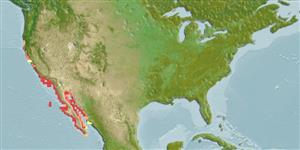>
Gobiiformes (Gobies) >
Gobiidae (Gobies) > Gobionellinae
Etymology: Gillichthys: Theodore Nicolas Gill (1837-1914) researcher of abyssal fishes and systematics + Greek, ichthys = fish (Ref. 45335).
Eponymy: Professor Theodore Nicholas Gill (1837–1914) was an American ichthyologist, malacologist, mammologist and librarian, a zoologist at George Washington University and associated with the Smithsonian Institution for more than half a century. [...] (Ref. 128868), visit book page.
Environment: milieu / climate zone / depth range / distribution range
Ökologie
seewasser; brackwasser demersal; tiefenbereich 4 - ? m (Ref. 96339). Subtropical; 42°N - 20°N, 125°W - 106°W
Eastern Pacific: California, northern to central Gulf of California.
Size / Gewicht / Alter
Maturity: Lm ? range ? - ? cm
Max length : 21.0 cm TL Männchen/unbestimmt; (Ref. 2850); common length : 13.0 cm TL Männchen/unbestimmt; (Ref. 12193); max. veröff. Alter: 2.00 Jahre (Ref. 56049)
Facultative air-breathing (Ref. 126274); Inhabits tidal flats, bays and coastal sloughs. Prefers mud bottom in shallow water. Non-emerging air-breather (Ref. 31184). Oviparous (Ref. 56079). Males guard the eggs which are found attached to the walls of brood chamber (Ref. 56079).
Female lays several thousand club-shaped eggs in nest built by male. Male guards eggs during 10-12 day incubation.
Eschmeyer, W.N., E.S. Herald and H. Hammann, 1983. A field guide to Pacific coast fishes of North America. Boston (MA, USA): Houghton Mifflin Company. xii+336 p. (Ref. 2850)
IUCN Rote Liste Status (Ref. 130435: Version 2024-2)
Bedrohung für Menschen
Harmless
Nutzung durch Menschen
Köder: usually
Tools
Zusatzinformationen
Download XML
Internet Quellen
Estimates based on models
Preferred temperature (Ref.
123201): 14.5 - 25.9, mean 22.3 °C (based on 138 cells).
Phylogenetic diversity index (Ref.
82804): PD
50 = 0.6250 [Uniqueness, from 0.5 = low to 2.0 = high].
Bayesian length-weight: a=0.01000 (0.00508 - 0.01968), b=3.09 (2.92 - 3.26), in cm total length, based on LWR estimates for this species & (Sub)family-body (Ref.
93245).
Trophic level (Ref.
69278): 3.2 ±0.35 se; based on food items.
Widerstandsfähigkeit (Ref.
120179): hoch, Verdopplung der Population dauert weniger als 15 Monate. (tmax=2;).
Fishing Vulnerability (Ref.
59153): Low vulnerability (11 of 100).
